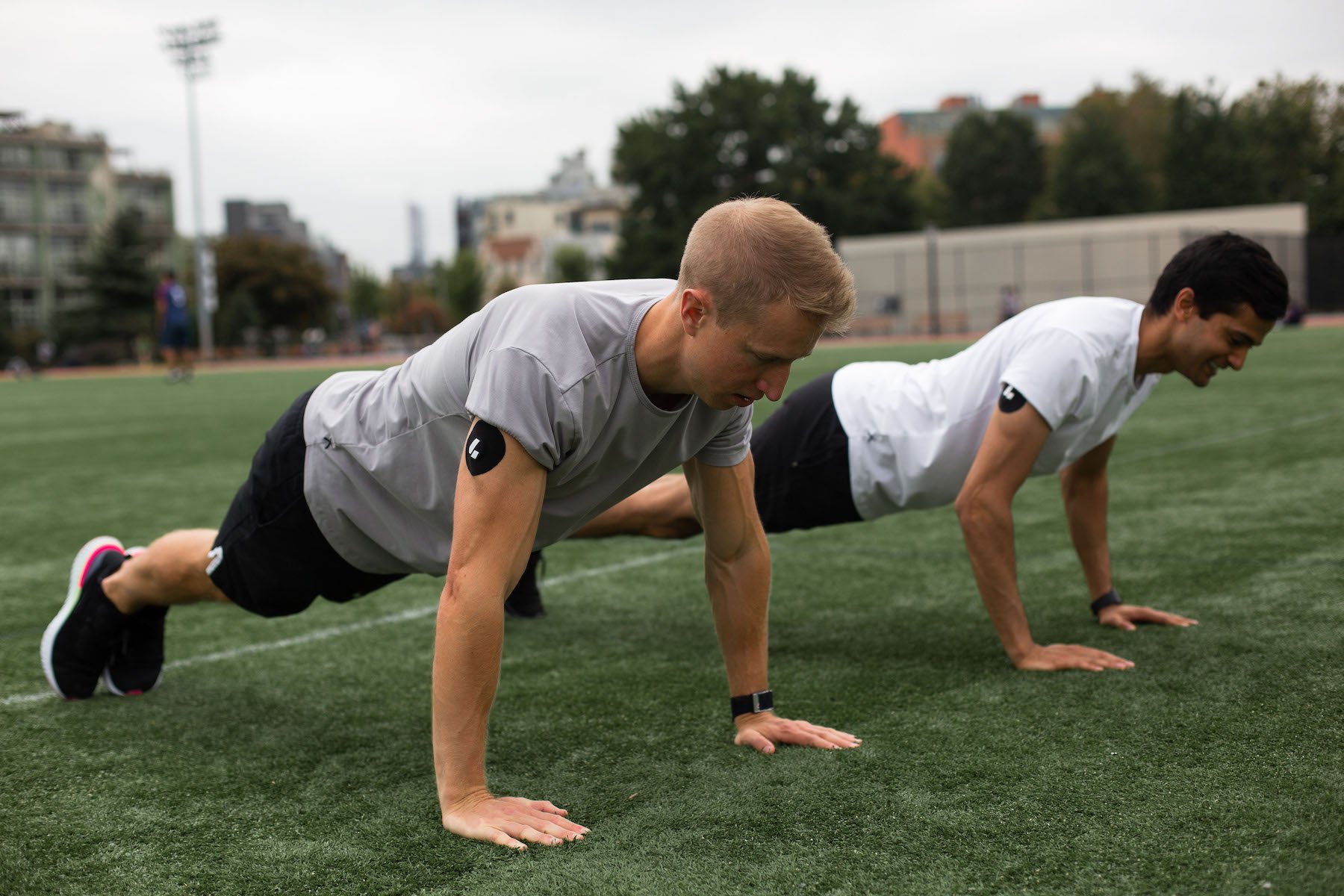A quick coffee gets your early-morning gym session started, and it’s common to see athletes with shaker bottles exiting the gym with a post-workout protein shake. But what about the time between the coffee and the protein shake? Should athletes be eating during the workout? If so, how much, when, and what should they eat to optimize performance?
“The key is to be efficient at using both fats and carbohydrates for energy. Your ability to flip-flop and efficiently use both of these forms of energy is called metabolic flexibility.”
These questions don’t have simple answers. While we accept that we will become physically tired during training, how do we know if we are getting tired more than necessary because we aren’t fueling properly? Could this lack of energy be fixed by fueling during our workout? Furthermore, how can metabolic tracking tools like continuous glucose monitors (CGM) provide feedback on energy utilization to optimize performance?
This article will dive into:
- How our muscles use fuel to perform
- Types of fuel
- When we may (or may not) need to supplement our body’s natural energy stores
- How ketogenic diets and intermittent fasting influence fueling strategies
- How a CGM can provide feedback to ensure you are fueling appropriately for your goals
What do you mean by “fuel”?
Calories are your body’s energy currency. Each macronutrient (carbohydrate, protein, fat) contains a different portion of energy. Each gram of carbohydrate contains 4 calories, each gram of protein contains 4 calories, and each gram of fat contains 9 calories.
Your first thought might be that fat is your best bet for athletic performance because it provides the greatest amount of energy for each gram. Unfortunately, it’s not that simple. Fat molecules take longer to dissociate and become available for fuel; carbohydrates, on the other hand, provide less energy but are available for use faster. Both types of fuel can be advantageous for performance when utilized appropriately. The key is to be efficient at using both fats and carbohydrates for energy. Your ability to flip-flop and efficiently use both of these forms of energy is termed metabolic flexibility.
What types of fuel are used in exercise, and how do they cause fatigue?
Fuel during exercise comes from, predominantly, three sources:
- Fat already in your body (stored fat)
- Glycogen (a stored form of glucose) stored in your muscle cells and liver
- Carbohydrates that you ingest before or during exercise
Stored fat is primarily used for low-intensity exercise, meaning exercise under approximately 60% VO2max (e.g., walking or a long easy bike ride). Minimal to no glycogen is used during very low-intensity exercise (less than 20% VO2max). As you increase in intensity, the proportion of glycogen used for fuel gradually increases, but fat is still the predominant fuel source for exercise under about 60% VO2max.
Your stored fat gives you the largest bang for your buck in terms of energy. You can exercise for hours at this pace since your body has a huge store of calories stored as fat, making fat a great fuel source for long sustained efforts. The caveat is that fat is primarily usable under intensities of approximately 60% VO2max. Thus, while you may be able to travel a long distance, you won’t be able to travel it at max speed.
Think of fuel source number 2, stored glycogen, as your reserve tank. Your muscles store glycogen, which can be broken down and used to contract skeletal muscle when you need it. Your liver’s glycogen “reserve tank” of stored glucose can be used to maintain adequate levels of glucose in the blood. While glycogen is a great source of quick fuel for sprints or a few short high-intensity efforts, these reserve tanks can only hold a certain amount of fuel. The average male (154 lbs) can store between 1600 and 2400 kcals of glycogen-based energy in the muscle and liver combined. That translates to about 10-15 kcals per pound of body weight. This amount of fuel will be significantly depleted after only about 90 min of high-intensity exercise. What happens if your high-intensity exercise or competition is longer than 90 minutes, or if you start your athletic event with depleted glycogen stores?
In that scenario, you have two main options:
- If you continue to exercise, you deplete your muscle and liver reserves, and muscle cells won’t be able to produce energy (ATP) rapidly enough to maintain exercise intensity, and you “bonk.” This option is neither pleasant nor conducive to a strong performance.
- Avoid the unpleasantries, increase your performance capabilities, and either ingest carbohydrates or try a carbohydrate mouth rinse.
That brings us to fuel source number 3: carbohydrates that you ingest during exercise. Carbohydrates are the primary energy source needed to facilitate sustained muscle contractions during exercise. So, if you are an athlete in a sport with repeated sprints, interval efforts, or sustained high-intensity exercise lasting longer than 45 minutes, then ingesting carbohydrates during exercise will help to spare liver glycogen stores and delay the onset of fatigue. The duration and intensity of exercise largely dictate the amount of carbohydrates needed.
How to fuel properly
To determine how to properly fuel your exercise, we need to specify the duration and intensity of your workout. Please keep in mind that we are talking about fueling during competitions for optimal performance. We will dive into the intricacies of fueling for training, health/metabolic goals, reducing fatigue, and building muscle in future blog posts. Additionally, pre and post-exercise are different beasts and will also be discussed in future blog posts. This post is about what you need during your athletic event.
While traditional fueling guidelines provide a range of carbohydrate intake per hour for optimal performance, which is a good starting point, newer tools exist that may help track carbohydrate needs even more. For instance, continuous glucose monitors (CGM) can report real-time glucose levels in the body during a workout. This technology provides a unique opportunity to personalize and dial in your fueling strategy to ensure that it is most effective and least damaging. These quantitative tools can give a snapshot of how the body is utilizing different sources of energy.
Duration Less Than 45 Min, Low Intensity (Less Than 60% VO2max)
E.g., easy bike ride/run/swim, walking the dog, yoga, curling
What do you want to see from your CGM to optimize performance during competition? If you are performing low-intensity exercise, then your blood sugar should not rise. In fact, you may see a brief dip in blood glucose at the onset of exercise while your body uses the readily available glucose already in circulation (it’s a quick and easy fuel source) in combination with stored fat. Since the intensity of exercise is not high enough to cue your liver to mobilize stored glycogen, after you burn through the small amounts of glucose in circulation, your blood sugar should be steady as you primarily use fat for energy.
You can use the feedback provided by your CGM to check that you are exercising at your desired intensity. For example, if your goal is to utilize fat as a fuel source, or you have an easy day planned and want feedback to ensure you are not overexerting yourself, then you should shoot for your blood sugar levels to have a slight dip at the onset of exercise then be steady the rest of the workout. A sudden increase in blood glucose could indicate your body is mobilizing stored glycogen to use as fuel, which is a sign that the intensity of the workout has increased beyond the capabilities of fat oxidation or that you ate something with carbohydrates right before your workout. If the goal is to perform a low-intensity exercise and primarily utilize fat oxidation, this should be avoided.
Fueling insights: No extra fuel is needed, nor will additional fuel enhance performance. These exercises’ low intensity and short duration indicate that glucose already in circulation and stored fat will be preferentially utilized as fuel.
Duration Less Than 45 Min, Power Sports
E.g., weightlifting, powerlifting, field events
While many sports can be simplified into “high” or “low” intensity, power sports are in a league of their own. Maximal muscle contractions are required to succeed. In competition, these maximal contractions will need to be repeated to advance through the rounds and compete for the win.
What do you want to see from your CGM to optimize performance during competition? For muscles to produce a maximal contraction, they need adequate amounts of glucose. The muscles get this glucose from stored glycogen in the liver and the muscle cells themselves. Often, people may see a rise in glucose during power sports as liver glycogen is released into the bloodstream as glucose to supply the muscles.
Fueling insights: Stored liver and muscle glycogen will get you through the early parts of a power sports event. Later in the event, eating a moderate amount of healthy glucose sources can help fuel maximal muscle contractions when glycogen may be running low. A little can go a long way, and big glucose spikes should be avoided, as they may lead to large insulin spikes that can impair fat oxidation and gluconeogenesis (the process by which the body can make new glucose from other building blocks like lactate, glycerol, certain amino acids, and potentially ketone bodies in times of low glucose availability).
Duration Less Than 45 Min, High Intensity (More Than 80% VO2max)
E.g., interval bike ride/run/swim, tennis match, track events, cross country skiing, beach volleyball
What do you want to see from your CGM to optimize performance during competition? At high intensities, you will primarily be using glucose for energy, in the form of circulating glucose, glycogen, glucose ingested during the workout. On competition day, you want to make sure that you are not starting with extremely low blood sugar; if the athletic event starts at a high intensity, then you will be depleting your glycogen stores quickly, leaving you to rely on in-race feeding for any subsequent high-intensity efforts (aka the sprint finish). On the flip side, you also don’t want to start with extremely high glucose levels from a big carb-load before the workout, as this will cause insulin to rise and may impair the ability to utilize fat as a supplemental source of fuel (at high intensities, approximately ⅓ of energy will still come from fat, and you don’t want to impair that). Checking your CGM can give you a sense of how much circulating glucose you have when you begin and is a clue as to whether fueling might be necessary during the workout.
At the beginning of high-intensity exercise, your body secretes specific hormones called catecholamines, which cause glucose release from the liver to increase up to eight-fold. Thus, it is not unusual to see a rise in your blood glucose at the beginning of a high-intensity workout. This rise is an indication that you are mobilizing your stored glycogen (meaning the workout is too intense for your body to rely primarily on fat and needs to use glucose as fuel). This increase in blood glucose during intense exercise can increase further immediately at exhaustion and persists for up to one-hour post-workout.
If you are competing in a self-paced sport (e.g., cycling time trial or triathlon) and want to check whether you are working at a high intensity, seeing a rise in blood glucose at the beginning of your workout is a clue that you may be mobilizing glucose from your liver to fuel your muscles.
Fueling insights: Some recent studies have shown that mouth rinsing for 5-10 seconds (and not swallowing) a carbohydrate solution (composed of ~6% carbohydrate) can improve performance in short (30 min to 70 min) intense (more than 80% VO2max) exercise. This is an intriguing finding since less than 45 minutes of exercise should not deplete our glycogen stores fully; therefore, there should be no need for additional carbohydrates to fuel muscle contractions. However, the reason behind mouth rinsing’s efficacy may be elucidated by brain imaging studies that have identified areas of the brain activated when carbohydrate is rinsed in the mouth, indicating the central nervous system may be driving the association between mouth rinsing and improved performance. The brain signals illuminated by mouth rinsing can produce afferent signals that modify motor output. It’s as if the brain senses more energy may become available, and it rises to the challenge. You’ve probably already seen mouth rinsing in action. English Premier League athletes have been rinsing and spitting on the sidelines for years, as well as pro football players and runners.
If you started with low glycogen stores because you were fasting or in a ketogenic diet, you might want to supplement with some ingested carbohydrates towards the end of a workout to optimize performance, but you do not want to consume so much that you see a large spike in glucose levels, which would indicate a subsequent insulin surge and possible impairment of fat oxidation or gluconeogenesis for energy.
Duration 45-180+ Min, Low Intensity (Less Than 60% VO2max)
E.g., tai chi, casual hiking, golf, baseball
What do you want to see from your CGM to optimize performance during competition? Same as “Duration less than 45 min, Low Intensity (less than 60% VO2max).”
Fueling insights: Extra fuel is not required, nor will additional fuel enhance performance. These exercises’ low intensity and short duration indicate that stored fat will be preferentially utilized as fuel. If you have one or two short sprints over the course of your workout, you don’t need to panic and reach for fuel. Your stored glycogen can adequately fuel a couple of quick bursts.
However, if your muscle glycogen was low before beginning exercise because of a low carbohydrate diet or fasting, then you might see a drop in blood sugar after those quick bursts. If the rest of your workout is low-intensity, then there is no need to fuel. Your fat can carry you through. However, if you still have a sprint or two left and your workout begins to encroach upon the middle ground between low and high intensity, you can take in small amounts of carbohydrates as tolerated to help you finish the last few sprints strong.
Duration 45-75 Min, High Intensity (More Than 80% VO2max)
E.g., soccer game, field hockey, lacrosse
What do you want to see from your CGM to optimize performance during competition? same as “Duration less than 45 min, High Intensity (more than 80% VO2max).”
Fueling insights: Extra fuel is not required as glycogen stores should be sufficient in a healthy individual to sustain 75 minutes of activity. However, if you’re starting with low glycogen stores (either because you are on a low-carbohydrate diet or fasted), then oral intake of fuel might be required towards the end of the event to maintain high intensity. This can be achieved by mouth rinsing with carbohydrate solution or ingesting small amounts of carbohydrates as tolerated (predominantly in the form of glucose and low in fiber). Liquid carbohydrates (30-60 grams per hour) should be consumed at 15-20 minute intervals throughout the exercise.
Duration 75-180 Min, High Intensity (More Than 80% VO2max)
E.g., triathlon, open water swimming, marathon
What do you want to see from your CGM to optimize performance during competition? Same idea as “Duration less than 45 min, High Intensity (more than 80% VO2max),” but you will likely need to consume fuel before or during the event if you want to optimize performance in longer duration exercise and avoid “bonking,” the term often used by athletes to refer to running out of energy and hitting the wall. Remember, the average person who has neither fasted nor followed a low carbohydrate diet has about 90 minutes worth of high-intensity exercise fuel stored as glycogen.
At this intensity, you’re going to be relying mostly on glycogen stores, which will get depleted with a longer high-intensity workout. As these become depleted, glucose values on a CGM may start to dip, which may indicate that you want to fuel during your workout.
When fueling before a workout to ensure optimal glycogen stores for a longer high-intensity workout, it seems that a good option is to ingest carbohydrates 2-3 hours before the workout, rather than immediately before the workout (meaning any time within 60 minutes of the workout). This is because the carbohydrates will likely generate a glucose and insulin surge, and that insulin can impair fat oxidation and gluconeogenesis. If this happens 2-3 hours before the workout, the glucose will be stored as glycogen, and the insulin will likely recover down to normal levels by the time of initiation of the workout. This means that you’ve successfully filled the glycogen tank and have hormones at a good level to tap into fat oxidation during the event, which is a good scenario. On your CGM, this would look like a small glucose rise 2-3 hours before the workout that returns to baseline by the time of the athletic event.
When fueling during the workout, we also don’t want to generate an excessive spike, which can cause a large release of insulin and impair fat oxidation and gluconeogenesis during the event. Getting some carbs in, but not in extreme excess, will likely support the optimal hormonal balance.
Fueling insights: Aim for 30-60 grams of carbohydrate per hour (predominantly in the form of glucose and low in fiber). Liquid carbohydrates should be consumed at 15-20 min intervals throughout exercise, while gels are optimally consumed every 20-40 min. We need more research assessing the use of mouth rinsing for exercise lasting longer than 70 minutes, but it is unlikely that it will be as effective as consuming carbohydrates, as in this case, we actually need the fuel. Thus, your best bet is to consume your fuels rather than rinse and spit.
Duration More Than 180 Min, High Intensity (More Than 80% VO2max)
E.g., road cycling, marathon
What do you want to see from your CGM to optimize performance during competition? Same as “Duration 75-180 min, High Intensity (more than 80% VO2max)”.
Fueling ideas to achieve optimal CGM feedback: Select your liquid, gel, or food of choice and shoot for consuming 90-110 grams of carbohydrate per hour (in a 2:1 ratio of glucose to fructose to optimally utilize multiple transport methods). Glucose uses GLUT2 and GLUT4 channels to transport across the cell membrane, and fructose uses GLUT5 channels. Thus, by utilizing both of these transmembrane carriers, you can maximize the amount of fuel entering the cell.
What about Different Diets?
Ketogenic and Low Carbohydrate Diets
A ketogenic (keto) diet involves an extremely low intake of carbohydrates intended to encourage the body to burn fat as fuel. There are a few types of ketogenic diets, which differ in their macronutrient ratio (some have a slightly higher carbohydrate allowance than others). Keto diets have been shown to both improve insulin sensitivity and increase weight loss. How does this diet impact athletic performance?
Studies investigating the effect of a ketogenic diet on anaerobic athletes found that, in general, it was not an effective way to increase anaerobic performance, such as weight lifting. In fact, “ketogenic diets have the potential to nullify the expected increases in lean body mass that results from anaerobic training.” Strength and power athletes, in particular, would likely not want to utilize a ketogenic diet during a competition, since maximal muscle contractions rely on glucose. Thus, the depleted glycogen stores and lack of carbohydrates that accompany a ketogenic diet could hinder an athlete’s ability to perform a max lift/jump/etc.
Endurance athletes have also experimented with keto diets. Theoretically, the large availability of fat in the body should transfer into increased whole-body and muscle fat utilization rates if these pathways are more active in a keto-adapted athlete. Endurance athletes hoped that this would parlay into improved performance in submaximal (less than 60% VO2max) aerobic exercise. Ketogenic diets result in greater fat oxidation rates, and some studies have shown that consumption of a ketone ester-containing beverage improved endurance performance (read an excellent guide to exogenous ketones for performance here at the HVMN blog). However, while energy utilization is altered, studies have been mixed in showing whether a ketogenic diet is beneficial for performance when compared to healthy individuals on a carbohydrate-rich diet.
A ketogenic diet may impair performance on high-intensity activities due to a lack of quickly available fuel (aka carbohydrates or glycogen). Thus, while it theoretically makes sense for keto diets to improve performance, it is probably not the optimal choice on competition day, when readily available glucose can help at high intensities.
“It’s important to remember that everyone’s physiology is different.”
A balance may lay in the concept of “carbohydrate cycling,” where athletes train in a low-carbohydrate state or maintain low carbohydrate intake during rest days, thereby generating adaptations in their fat-burning pathways, but then supply the body carbohydrates on days when maximal performance is necessary.
Indeed, while ketogenic diets are likely not an effective performance advantage on race day for high intensity or power athletes, they may have a place outside of competition for health benefits and general adaptations in energy utilization. If you want to give the keto diet a try, you can use your CGM to help. While on a ketogenic diet, your glucose readings will likely be fairly low-normal with minimal swings, indicating that neither glycogen nor carbohydrates are being used as a primary substrate for fuel. The lower insulin levels generated from not consuming significant carbohydrates allow for more efficient fat oxidation. Over time, this can increase metabolic flexibility, allowing the body to shift between different fuel sources efficiently based on what is available.
Intermittent Fasting
The concept of fasting is not new, but the concept has gained traction in the media over the past few years. People elect to engage in intermittent fasts for a variety of reasons: religious beliefs, weight loss, decreasing blood pressure, or to reduce the risk of metabolic diseases. There are a variety of different protocols utilized to obtain the desired results, such as the 16/8 (16 h fast followed by 8 h of food intake), 5:2 (alternating full days of fasting with eating), or the Muslim fast during Ramadan (1 month with no food or liquid consumed during daylight hours).
When seeking to utilize this strategy for improved athletic performance, we can break it down by exercise type. Training fasted will likely not benefit strength or power athletes since carbohydrates fuel maximal muscle contractions. Thus, if you attempt this type of exercise after a prolonged fast, then it is likely that your blood sugar will remain low and steady or have a minor increase from the release of a small amount of stored liver glycogen, but that your performance will be diminished since you don’t have the fuel to perform maximal muscle contractions.
Fasting has not been shown to be an effective performance-enhancing technique for sprinters (a form of high-intensity exercise that relies on a higher percentage of glucose), even when studies controlled for the potential confounding factors of sleep and training load. Athletes competing in sports that require repeated sprints also failed to benefit from intermittent fasting.
Endurance sports, on the other hand, may benefit from alternate-day feeding or intermittent fasting. This may be because training in a fasted state allows our body to become more adapted to utilize fat as an energy source. A study by Marosi et al. found that one month of alternate-day feeding produced mice that ran further and for a longer period than mice that were allowed to eat as desired.
While fasting, blood glucose on CGM will likely trend to a low and steady level since you have minimized your ingested glucose and glycogen stores, and fat is being used for fuel. As mentioned previously, in times of low glucose availability, the body can also make new glucose from other sources like lactate, glycerol, certain amino acids, and potentially ketone bodies, a process called gluconeogenesis.
Summary
It’s important to remember that while these research-backed guidelines help provide a barometer of how much and what type of fuel is optimal for performance, everyone’s physiology is different. So, while the recommended amount of carbohydrates may work perfectly for one individual, it may not be enough if that person gains muscle mass, works at a higher intensity, has a different diet, competes in a warmer climate, or is at a different phase of their menstrual cycle.
This is where continuous glucose monitors (CGMs) may emerge as helpful adjuncts for athletes. Given that there are so many variables in athletics, CGMs can provide a bit more clarity into how the body is utilizing different energy sources during athletic performance. It also can help take some of the guesswork out of fueling during exercise, helping to know quantitatively when you might be getting close to bonking, or, on the flip side, it can ensure that you don’t overshoot on your fueling and generate a hormonal cascade that may be counter-productive.








